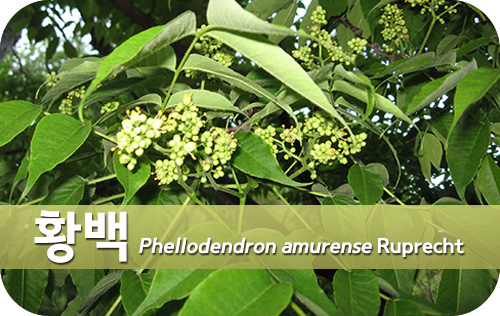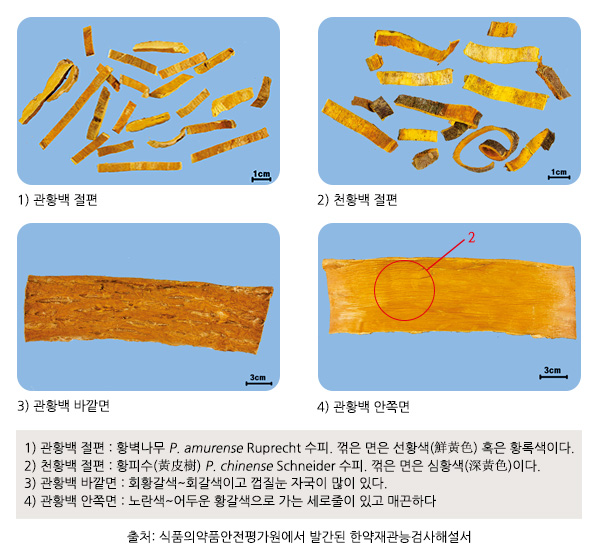황백은 운향과 (Rutaceae) 황백속 (genus Phellodendron)에 속하는 황벽나무 (Phellodendron amurense Ruprecht) 또는 황피수 (黃皮樹, Phellodendron chinense Schneider)의 줄기껍질로서 주피를 제거한 것이다. <중국약전>의 경우 황피수를 ‘천황백 (川黃柏)’으로 부르며, 황피수만을 황백의 기원식물로 인정한다.
전통적 사용
황백이 약용식물로 처음 기록된 것은 <신농본초경>으로 ‘황달, 장치질을 치료하고, 설사와 여성의 적백대하(赤白帶下)를 그치게 한다. 음부가 손상하여 썩는 상처를 치료한다’ 고 적고 있다. 황백속에 속하는 몇몇 종의 수피는 중국과 일본에서 위장 및 이질의 치료에 사용했다.
성분
황백의 알칼로이드 성분 분석에 따르면 berberine (0.50-8.75%), palmatine (0.04-0.95%) 성분이 가장 풍부하며, jateorrhizine (0.02-0.10%)은 적은 편이다 [1]. 이외에도 phellodendrine, magnoflorine 등의 알칼로이드 성분과 liminoids 등의 비알칼로이드 성분이 함유되어 있다 [2,18].
황벽나무와 황피수를 비교한 연구에 따르면, 황피수는 황벽나무에 비해 berberine 함량이 3배 이상이며, palmatine은 절반 이하로 적었다 [1]. 또한 황백 (P. chinense)을 포제하면 berberine 함량이 11.8~98% 감소한다고 보고되었다 [3].
약리작용
1. 항균, 항바이러스 작용
2. 수렴 작용
3. 항염증 작용
4. 항산화 작용
5. 항암 작용
6. 기타
1. 항균, 항바이러스 작용
황백의 주성분인 베르베린 (berberine)에는 황색포도상구균, 적리균, 콜레라균, 임균 등에 대한 항균 작용이 있다. 황백의 항균 작용은 물보다 에탄올 추출이 더 효과적이다 [4]. 또한 황백의 물 추출물은 바이러스 복제를 유의하게 감소시키는데, 이는 주요 지표 성분인 베르베린의 작용으로 확인되었다 [5].
2. 수렴 작용
황백은 전통적으로 설사에 사용되었는데, 이는 일부 베르베린의 작용으로 생각된다. Zhang Y 등의 연구 (2012)에 따르면, sennoside A 및 human intestinal epithelium cell line (HIEC) 유발 설사 mouse 모델에 베르베린을 처치하면 NHE3 및 AQP4 및 발현을 증가시키며, 베르베린이 Na+와 물의 흡수를 향상시킴으로써 항설사 효과를 나타낼 수 있음이 시사되었다 [19].
3. 항염증 작용
국소 항염증 활성 연구에서 황백 추출물은 TPA, oxazolone, arachidonic acid로 유도된 부종을 억제했다. 코브라 (Naja naja)의 PLA2 (phospholipase A2) 활성은 억제하지 못했다 [6]. Park EK 등은 황백, 황련 2:1 비율의 항염증 작용을 평가했다. 급만성 염증 모델에서 황백 조합은 항염증 작용을 나타냈다 [7]. 이외에도 LPS 유도 급성 기도 염증에서 황백 메탄올 추출물의 억제 효과 [8] 및 acetic acid 유도 만성 위염 모델에서 황백의 항궤양 작용이 보고된다 [9].
4. 항산화 작용
황백잎에 함유된 quercetin, quercetin-3-O-beta-D-glucoside, quercetin-3-O-beta -D-galactoside 및 kaempferol-3-O-beta-D-glucoside는 자유라디칼 제거 작용이 있으며, 이는 비타민 E에 상당히 많다 [10]. 황백수피의 포제에 따른 자유라디칼 제거 및 항지질과산화 활성이 연구되었는데, 주초 황백 (stir-fried with yellow alcohol) 80% 에탄올 추출물이 가장 효과적이었다 [11].
5. 항암 작용
황백에 함유된 베르베린의 항암 작용이 다수 연구되었다 [20]. 특히 황백 추출물인 Nexrutine®의 항전립선암 작용 연구가 다수 보고되었다. Nexrutine®는 Akt와 CREB-매개 신호 전달 경로의 조절을 통해 전립선암 세포의 증식을 억제했으며 [12], 이후 TRAMP mice를 대상으로 한 in vivo 연구에서 20주간의 투여는 암의 진행을 유의하게 억제함을 보고했다 [13]. 2015년에는 수술 1-2개월 또는 방사선 치료 1-2개월 전 선행 보조 치료로 Nexrutine®을 복용한 21명 환자 (수술 9명, 방사선 치료 12명)의 임상연구를 보고했다. 시험 종료 후 환자의 81%에서 전립선, 특히 항원의 감소가 나타났으며, 순응도가 높고 독성이 적었다고 보고했다 [14]. 또한 최근에는 Nexrutine®의 항췌장암 세포 활성이 보고되었다 [15].
6. 기타
여드름 환자에게 황백 피부 마스크를 8주 적용했을 때, 약간의 효과가 나타남을 보고했다. 다른 치료와 황백 마스크의 병행이 가능할 것임이 시사되었다 [16].
또한 황백은 지모와 함께 성조숙증 등에 사용되는데 최근에 사춘기에 들어 선 암컷 래트를 대상으로 성장과 성숙에 미치는 효과를 평가했다. 그 결과, 황백은 사춘기 발달에 아무런 영향을 끼치지 못했으나, 성장판에서 IGF-1, BMP-2을 통해 골 성장을 자극했다 [17].
참고문헌
[1] Ryuk JA, Zheng MS, Lee MY, Seo CS, Li Y, Lee SH, Moon DC, Lee HW, Lee JH, Park JY, Son JK, Ko BS. Discrimination of Phellodendron amurense and P. chinense based on DNA analysis and the simultaneous analysis of alkaloids. Arch Pharm Res. 2012 Jun;35(6):1045-54. doi: 10.1007/s12272-012-0612-y.
[2] Sheridan H, Bhandari P. Cathin-6-one from the Root Bark of Phellodendron chinense. Planta Med. 1992 Jun;58(3):299.
[3] Zhou H, Gu Y. Determination of berberine in Phellodendron chinense Schneid and its processed products by TLC (thin layer chromatography) densitometry. Zhongguo Zhong Yao Za Zhi. 1995 Jul;20(7):405-7, 447.
[4] Wang W, Zu Y, Fu Y, Reichling J, Suschke U, Nokemper S, Zhang Y. In vitro antioxidant, antimicrobial and anti-herpes simplex virus type 1 activity of Phellodendron amurense Rupr. from China. Am J Chin Med. 2009;37(1):195-203.
[5] Kim JH, Weeratunga P, Kim MS, Nikapitiya C, Lee BH, Uddin MB, Kim TH, Yoon JE, Park C, Ma JY, Kim H, Lee JS. Inhibitory effects of an aqueous extract from Cortex Phellodendri on the growth and replication of broad-spectrum of viruses in vitro and in vivo. BMC Complement Altern Med. 2016 Aug 2;16:265. doi: 10.1186/s12906-016-1206-x.
[6] Cuéllar MJ, Giner RM, Recio MC, Máñez S, Ríos JL. Topical anti-inflammatory activity of some Asian medicinal plants used in dermatological disorders. Fitoterapia. 2001 Mar;72(3):221-9.
[7] Park EK, Rhee HI, Jung HS, Ju SM, Lee YA, Lee SH, Hong SJ, Yang HI, Yoo MC, Kim KS. Antiinflammatory effects of a combined herbal preparation (RAH13) of Phellodendron amurense and Coptis chinensis in animal models of inflammation. Phytother Res. 2007 Aug;21(8):746-50.
[8] Mao YF, Li YQ, Zong L, You XM, Lin FQ, Jiang L. Methanol extract of Phellodendri cortex alleviates lipopolysaccharide-induced acute airway inflammation in mice. Immunopharmacol Immunotoxicol. 2010 Mar;32(1):110-5. doi: 10.3109/08923970903193325.
[9] Wang L, Wang X, Zhu XM, Liu YQ, Du WJ, Ji J, He X, Zhang CF, Li F, Guo CR, Wang CZ, Yuan CS. Gastroprotective Effect of Alkaloids from Cortex Phellodendri on Gastric Ulcers in Rats through Neurohumoral Regulation. Planta Med. 2017 Feb;83(3-04):277-84. doi: 10.1055/s-0042-114044.
[10] Leu CH, Li CY, Yao X, Wu TS. Constituents from the leaves of Phellodendron amurense and their antioxidant activity. Chem Pharm Bull (Tokyo). 2006 Sep;54(9):1308-11.
[11] Kong LD, Yang C, QuiXi, Wu HP, Ye DJ. Effects of different processing products of Cortex Phellodendri on scavenging oxygen free radicals and anti-lipid peroxidation. Zhongguo Zhong Yao Za Zhi. 2001 Apr;26(4):245-8.
[12] Garcia GE, Nicole A, Bhaskaran S, Gupta A, Kyprianou N, Kumar AP. Akt-and CREB-mediated prostate cancer cell proliferation inhibition by Nexrutine, a Phellodendron amurense extract. Neoplasia. 2006 Jun;8(6):523-33.
[13] Kumar AP, Bhaskaran S, Ganapathy M, Crosby K, Davis MD, Kochunov P, Schoolfield J, Yeh IT, Troyer DA, Ghosh R. Akt/cAMP-responsive element binding protein/cyclin D1 network: a novel target for prostate cancer inhibition in transgenic adenocarcinoma of mouse prostate model mediated by Nexrutine, a Phellodendron amurense bark extract. Clin Cancer Res. 2007 May 1;13(9):2784-94.
[14] Swanson GP, Jones WE 3rd, Ha CS, Jenkins CA, Kumar AP, Basler J. Tolerance of Phellodendron amurense bark extract (Nexrutine®) in patients with human prostate cancer. Phytother Res. 2015 Jan;29(1):40-2. doi: 10.1002/ptr.5221.
[15] Gong J, Muñoz AR, Chan D, Ghosh R, Kumar AP2. STAT3 down regulates LC3 to inhibit autophagy and pancreatic cancer cell growth. Oncotarget. 2014 May 15;5(9):2529-41.
[16] Zhang Y, Sun Y, Yan R, Lin Z, Zhang Y, Lu Y, Cui S, Wu Y. Application of Phellodendron amurense facial mask for slight to moderate acne vulgaris. Clin Exp Dermatol. 2018 May 28. doi: 10.1111/ced.13663.
[17] Lee SH, Lee HJ, Lee SH, Kim YS, Lee D, Chun J, Lee JY, Kim H, Chang GT. Effects of Huang Bai (Phellodendri Cortex) on bone growth and pubertal development in adolescent female rats. Chin Med. 2018 Jan 12;13:3. doi: 10.1186/s13020-017-0156-7.
[18] Fujii A, Okuyama T, Wakame K, Okumura T, Ikeya Y, Nishizawa M. Identification of anti-inflammatory constituents in Phellodendri Cortex and Coptidis Rhizoma by monitoring the suppression of nitric oxide production. J Nat Med. 2017 Oct;71(4):745-56. doi: 10.1007/s11418-017-1107-4.
[19] Zhang Y, Wang X, Sha S, Liang S, Zhao L, Liu L, Chai N, Wang H, Wu K. Berberine increases the expression of NHE3 and AQP4 in sennosideA-induced diarrhoea model. Fitoterapia. 2012 Sep;83(6):1014-22. doi: 10.1016/j.fitote.2012.05.015.
[20] Tang J, Feng Y, Tsao S, Wang N, Curtain R, Wang Y. Berberine and Coptidis rhizoma as novel antineoplastic agents: a review of traditional use and biomedical investigations. J Ethnopharmacol. 2009 Oct 29;126(1):5-17. doi: 10.1016/j.jep.2009.08.009.
© 공병희 원장의 현대적 본초 읽기


